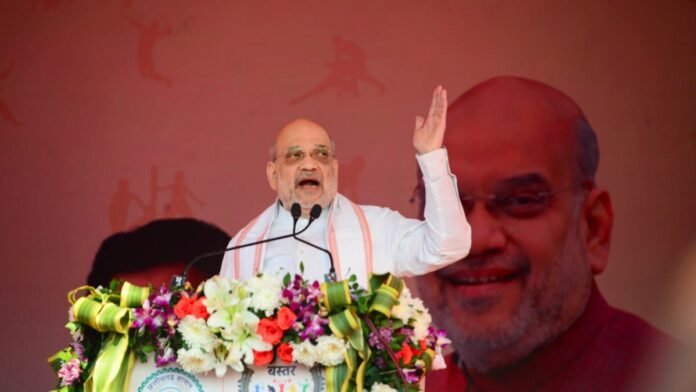Chhattisgarh, December 15, 2024 — Union Home Minister Amit Shah delivered a powerful and heartfelt message during his recent visit to Chhattisgarh, where he met with surrendered Naxals and participated in the closing ceremony of the Bastar Olympics. His statement, “I am the happiest person today,” underscored the government’s unwavering commitment to rehabilitating individuals who have abandoned violence and embraced peace.
This visit marked a pivotal moment in the government’s ongoing efforts to dismantle the Maoist insurgency in the region and reintegrate former militants into mainstream society. Shah’s words and actions reflected optimism, signaling a future of peace and development for areas long plagued by extremism.
A Meeting of Transformation: Surrendered Naxals Share Their Journeys
The highlight of Shah’s visit was his interaction with surrendered Naxals who have chosen to abandon violence and reintegrate into society. Shah expressed profound joy at hearing their stories of transformation, attributing their decisions to the government’s comprehensive rehabilitation policies.
Shah noted that these former militants are now benefiting from numerous welfare schemes, including housing initiatives, vocational training programs, and financial aid. He highlighted their contributions to society as evidence of the success of the government’s approach, which combines security operations with developmental and rehabilitative efforts.
“The decision of these individuals to surrender and embrace peace is a victory for humanity,” Shah said. “Their courage to start anew inspires hope for a better future in this region.”
Bastar Olympics: A Celebration of Peace and Unity
During his visit, Shah attended the closing ceremony of the Bastar Olympics, a unique sporting and cultural event that drew participants from across the region, including surrendered Naxals, victims of violence, and local youth. The event served as a powerful symbol of the region’s ongoing transformation from conflict to harmony.
The Bastar Olympics showcased traditional games and cultural activities, promoting community engagement and social integration. Shah praised the event as a testament to the region’s resilience and the growing trust in peace and development initiatives.
“The participation of surrendered Naxals and violence victims in this event is a clear indication of the changing mindset in Bastar. It represents a collective move towards harmony and development,” Shah remarked.
He emphasized that such events play a crucial role in fostering a sense of belonging among individuals who have renounced violence, offering them a platform to rebuild their lives and contribute positively to society.
Government Policies Driving Surrender and Rehabilitation
Shah credited the government’s proactive policies for the increasing number of Naxals choosing to surrender. Since 2019, the Ministry of Home Affairs has implemented a range of measures aimed at addressing the root causes of extremism while offering a viable path for militants to reintegrate into society.
Key elements of the rehabilitation program include:
- Financial Assistance: Surrendered Naxals receive monetary incentives to support their transition.
- Skill Development Programs: Vocational training ensures that they are equipped with employable skills.
- Housing Schemes: Access to safe and secure housing promotes stability and dignity.
- Education and Scholarships: Special provisions for the education of surrendered militants’ children help break the cycle of violence.
- Community Acceptance Programs: Local initiatives foster acceptance and integration within their communities.
Shah emphasized the importance of psychological support, noting that counseling and mental health services are integral to the rehabilitation process.
“These programs not only provide material support but also restore dignity and hope,” Shah explained. “The government’s approach is centered on compassion, understanding, and a genuine commitment to change.”
Positive Outcomes Since 2019
The government’s comprehensive approach has yielded significant results. Shah highlighted that thousands of militants have surrendered over the past five years, marking a steady decline in Maoist activity across the country.
“The surrender of these individuals is a testament to the effectiveness of our policies and the appeal of peace over violence,” Shah said.
He referenced past successes in peace accords and community-driven initiatives that have inspired militants to abandon extremist ideologies. These efforts have not only reduced violence but also paved the way for long-term development in previously neglected areas.
A Vision for a Maoist-Free India
Shah’s optimism extended beyond the present, as he outlined his vision for a Maoist-free India by March 2026. He expressed confidence that continued efforts, coupled with the cooperation of surrendered militants, could achieve this ambitious goal.
“Our mission is clear: to eradicate Maoist influence and bring lasting peace and prosperity to all affected regions,” Shah declared. “With the support of local communities and the courage of those who have chosen peace, I firmly believe this goal is within reach.”
Shah called on remaining Naxals to join the mainstream, assuring them of the government’s commitment to prioritizing their rehabilitation. He emphasized that surrender is not a sign of weakness but a step towards rebuilding lives and contributing to the nation’s progress.
Challenges and the Road Ahead
While significant progress has been made, challenges remain. Experts point to the need for sustained efforts in addressing socio-economic disparities and ensuring that surrendered Naxals are fully integrated into society.
Shah acknowledged these challenges, stressing the importance of collaboration between the government, local authorities, and community leaders. He reiterated that development and security must go hand in hand to achieve lasting peace.
“We are committed to addressing the root causes of extremism, from poverty and inequality to lack of education and employment opportunities,” Shah said. “Our approach is holistic, ensuring that no one is left behind in our journey towards peace.”
Inspiring Stories of Change
Several surrendered Naxals shared their experiences during Shah’s visit, offering a glimpse into their journeys from conflict to hope. Their stories highlighted the transformative power of the government’s rehabilitation programs and the role of community support in their reintegration.
One former militant, who surrendered two years ago, spoke about how access to vocational training enabled him to start a small business. Another shared how her children now attend school, breaking the cycle of violence that had gripped her family for generations.
“I never thought I could live a life of dignity and peace,” one individual said. “The government’s support has given me a second chance.”
Community Engagement: A Key to Success
Shah emphasized the role of community engagement in the rehabilitation process, noting that acceptance and support from local residents are critical to the success of surrendered militants’ reintegration.
Programs like the Bastar Olympics play a vital role in fostering social cohesion and creating opportunities for dialogue and understanding. By bringing together individuals from diverse backgrounds, such events help bridge divides and build trust.
Conclusion: A Step Towards Peace and Prosperity
Amit Shah’s visit to Chhattisgarh underscored the government’s commitment to peace, development, and rehabilitation. His interactions with surrendered Naxals and participation in the Bastar Olympics highlighted the transformative impact of proactive policies and community-driven initiatives.
As the government continues its efforts to eliminate Maoist influence, Shah’s message of hope and inclusivity resonates as a powerful call for unity and progress. By prioritizing rehabilitation and addressing the root causes of extremism, India moves closer to its vision of a peaceful and prosperous future for all.
Shah’s optimism and the success stories of surrendered Naxals serve as a reminder that change is possible when compassion, trust, and opportunity converge. The journey ahead may be challenging, but the path to peace is paved with the courage of those who choose it.



